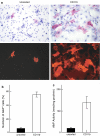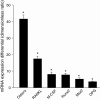Isolation of osteoprogenitors from murine bone marrow by selection of CD11b negative cells
- PMID: 19221888
- PMCID: PMC2652555
- DOI: 10.1007/s10616-009-9184-1
Isolation of osteoprogenitors from murine bone marrow by selection of CD11b negative cells
Abstract
Selection of cells having the most osteogenic potential is a strategy used in bone tissue engineering. Preclinical studies using murine bone marrow cells must consider the large amount of hematopoietic cells in the adherent fraction. The aim of this study was to enrich a murine bone marrow cell population with osteoprogenitors by using a simple and reliable method. Bone marrow from C57Bl/6 mice was extracted and cells which adhered onto plastic were expanded in primary culture for 14 days. Immunolabeling of the CD11b surface antigen was performed and the CD11b(-) cell fraction was isolated by FACS. Sorted and unsorted populations were analyzed for gene expression of osteoblast differentiation, alkaline phosphatase (AlkP) activity and matrix mineralization capacities. Selection of CD11b(-) cells increased the number of AlkP(+) cells from the plastic adherent fraction from 6.3% +/- 0.8 to 56% +/- 3.3 with a sevenfold increase in AlkP activity. mRNA analysis revealed a significant increase in the CD11b(-) fraction for Osterix (41-fold), RANKL (17-fold), M-CSF (8-fold) and Runx-2 (8-fold). An osteogenic population was obtained with improved capacities to produce a mineralized extracellular matrix in vitro, independently of the presence of glucocorticoids in the culture medium.
Figures




Similar articles
-
Basal and inducible Osterix expression reflect equine mesenchymal progenitor cell osteogenic capacity.Front Vet Sci. 2023 Mar 23;10:1125893. doi: 10.3389/fvets.2023.1125893. eCollection 2023. Front Vet Sci. 2023. PMID: 37035801 Free PMC article.
-
Osteogenic properties of late adherent subpopulations of human bone marrow stromal cells.Histochem Cell Biol. 2009 Nov;132(5):547-57. doi: 10.1007/s00418-009-0633-x. Epub 2009 Aug 27. Histochem Cell Biol. 2009. PMID: 19711092
-
Positive and negative immunoselection for enrichment of two classes of osteoprogenitor cells.J Cell Biol. 1991 Jul;114(2):373-84. doi: 10.1083/jcb.114.2.373. J Cell Biol. 1991. PMID: 1712792 Free PMC article.
-
Induction of rapid osteoblast differentiation in rat bone marrow stromal cell cultures by dexamethasone and BMP-2.Dev Biol. 1994 Jan;161(1):218-28. doi: 10.1006/dbio.1994.1022. Dev Biol. 1994. PMID: 8293874
-
Macrophage colony-stimulating factor pretreatment of bone marrow progenitor cells regulates osteoclast differentiation based upon the stage of myeloid development.J Cell Biochem. 2019 Aug;120(8):12450-12460. doi: 10.1002/jcb.28512. Epub 2019 Feb 25. J Cell Biochem. 2019. PMID: 30805994 Free PMC article.
Cited by
-
The hepcidin regulator erythroferrone is a new member of the erythropoiesis-iron-bone circuitry.Elife. 2021 May 18;10:e68217. doi: 10.7554/eLife.68217. Elife. 2021. PMID: 34002695 Free PMC article.
-
Enhanced cytotoxic T lymphocytes recruitment targeting tumor vasculatures by endoglin aptamer and IP-10 plasmid presenting liposome-based nanocarriers.Theranostics. 2019 May 31;9(14):4066-4083. doi: 10.7150/thno.33383. eCollection 2019. Theranostics. 2019. PMID: 31281532 Free PMC article.
-
Isolation and Differentiation of Mesenchymal Stem Cells From Broiler Chicken Compact Bones.Front Physiol. 2019 Jan 22;9:1892. doi: 10.3389/fphys.2018.01892. eCollection 2018. Front Physiol. 2019. PMID: 30723419 Free PMC article.
-
Loss of osteoblast Runx3 produces severe congenital osteopenia.Mol Cell Biol. 2015 Apr;35(7):1097-109. doi: 10.1128/MCB.01106-14. Epub 2015 Jan 20. Mol Cell Biol. 2015. PMID: 25605327 Free PMC article.
-
Chicken Mesenchymal Stem Cells and Their Applications: A Mini Review.Animals (Basel). 2021 Jun 24;11(7):1883. doi: 10.3390/ani11071883. Animals (Basel). 2021. PMID: 34202772 Free PMC article. Review.
References
-
- {'text': '', 'ref_index': 1, 'ids': [{'type': 'DOI', 'value': '10.1002/jcb.10507', 'is_inner': False, 'url': 'https://doi.org/10.1002/jcb.10507'}, {'type': 'PubMed', 'value': '12704799', 'is_inner': True, 'url': 'https://pubmed.ncbi.nlm.nih.gov/12704799/'}]}
- Atmani H, Chappard D, Baslé MF (2003) Proliferation and differentiation of osteoblasts and adipocytes in rat bone marrow stromal cell cultures: effects of dexamethasone and calcitriol. J Cell Biochem 89:364–372. doi:10.1002/jcb.10507 - PubMed
-
- {'text': '', 'ref_index': 1, 'ids': [{'type': 'DOI', 'value': '10.1002/(SICI)1097-4644(1998)72:30/31+<73::AID-JCB11>3.0.CO;2-L', 'is_inner': False, 'url': 'https://doi.org/10.1002/(sici)1097-4644(1998)72:30/31+<73::aid-jcb11>3.0.co;2-l'}, {'type': 'PubMed', 'value': '9893258', 'is_inner': True, 'url': 'https://pubmed.ncbi.nlm.nih.gov/9893258/'}]}
- Aubin JE (1998) Bone stem cells. J Cell Biochem Suppl 30–31:73–82. doi:10.1002/(SICI)1097-4644(1998)72:30/31+<73::AID-JCB11>3.0.CO;2-L - PubMed
-
- {'text': '', 'ref_index': 1, 'ids': [{'type': 'DOI', 'value': '10.1002/(SICI)1097-4644(19990301)72:3<396::AID-JCB9>3.0.CO;2-6', 'is_inner': False, 'url': 'https://doi.org/10.1002/(sici)1097-4644(19990301)72:3<396::aid-jcb9>3.0.co;2-6'}, {'type': 'PubMed', 'value': '10022521', 'is_inner': True, 'url': 'https://pubmed.ncbi.nlm.nih.gov/10022521/'}]}
- Aubin JE (1999) Osteoprogenitor cell frequency in rat bone marrow stromal populations: role for heterotypic cell–cell interactions in osteoblast differentiation. J Cell Biochem 72:396–410. doi:10.1002/(SICI)1097-4644(19990301)72:3<396::AID-JCB9>3.0.CO;2-6 - PubMed
-
- {'text': '', 'ref_index': 1, 'ids': [{'type': 'DOI', 'value': '10.1002/jcb.10594', 'is_inner': False, 'url': 'https://doi.org/10.1002/jcb.10594'}, {'type': 'PubMed', 'value': '12898521', 'is_inner': True, 'url': 'https://pubmed.ncbi.nlm.nih.gov/12898521/'}]}
- Baddoo M, Hill K, Wilkinson R et al (2003) Characterization of mesenchymal stem cells isolated from murine bone marrow by negative selection. J Cell Biochem 89:1235–1249. doi:10.1002/jcb.10594 - PubMed
-
- {'text': '', 'ref_index': 1, 'ids': [{'type': 'DOI', 'value': '10.1172/JCI10413', 'is_inner': False, 'url': 'https://doi.org/10.1172/jci10413'}, {'type': 'PMC', 'value': 'PMC378520', 'is_inner': False, 'url': 'https://pmc.ncbi.nlm.nih.gov/articles/PMC378520/'}, {'type': 'PubMed', 'value': '10862779', 'is_inner': True, 'url': 'https://pubmed.ncbi.nlm.nih.gov/10862779/'}]}
- Bianco P, Gehron Robey P (2000) Marrow stromal stem cells. J Clin Invest 105:1663–1668. doi:10.1172/JCI10413 - PMC - PubMed
LinkOut - more resources
Full Text Sources
Research Materials

